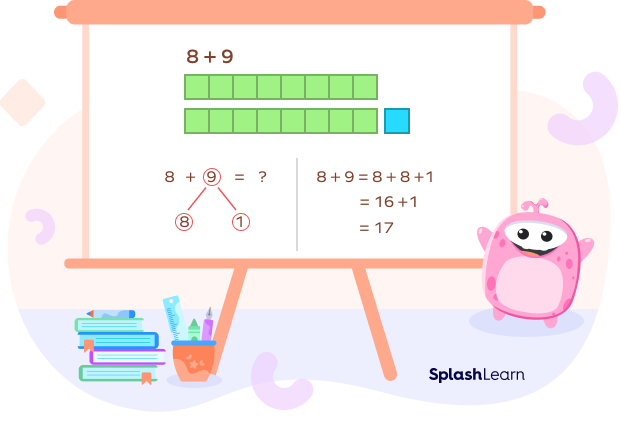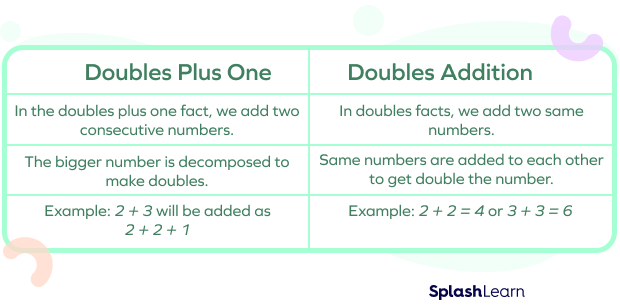What Are Doubles Plus One?
Using a strategy-based approach to adding and subtracting helps to master addition and subtraction facts. One such strategy we use to understand addition or subtraction facts is the doubles strategy or fact.
When we add two of the same number, we add using the “doubles fact”.
For example, 1 + 1 and 2 + 2 are both doubles facts.
Look at the example below:

4 + 4 = 8 is a doubles fact. Doubles fact can help us know other additional strategies like doubles plus one. This strategy is used in the addition of two consecutive numbers, like 2 + 3. Here, we break one of the addends to make a double with the other addend.
Recommended Games
How to Add Numbers with the Doubles Plus One Method
Knowing doubles facts lays a foundation for solving doubles plus one addition. Let’s begin by adding two consecutive numbers using this method.
For example, consecutive numbers 8 and 9 have been added using the strategy.

We know that 8 + 8 is 16, so 8 + 9 = 17
Let’s look at another example of this strategy. Use the image to solve 4 + 5.

We know that 4 + 4 = 8, so 4 + 5 = 4 + 4 + 1 = 8 + 1 = 9
Recommended Worksheets
What Is the Difference between “Doubles Plus One” and “Doubles Addition”?
Using the table below, let us understand the difference between doubles and doubles plus one.

Fun Fact!
Doubles plus 1 and doubles minus one are called “near doubles strategies”.
Solved Examples
Example 1: Fill in the blanks using a strategy:
4 + 3 = _ + _ + 3
6 + 7 = 6 + _ + _
Solution: Using the doubles plus 1 method:
4 + 3 = 3 + 1+ 3
6 + 7 = 6 + 6 + 1
Example 2: Add using the near doubles fact.

Solution: Since 5 + 5 = 10 , 5 + 6 is one more than 5 + 5.
So, 5 + 6 = 5 + 5 + 1 = 11
Example 3: Solve the following equations using doubles plus 1:
- 101 + 100 = ?
- 40 + 41 = ?
Solution:
- Since we know 100 + 100 = 200,
101 + 100 = 100 + 1 + 100 = 201
- Since we know 40 + 40 = 80,
40 + 41 = 40 + 40 + 1 = 81
Practice Problems
Doubles Plus One - Definition With Examples
Select the number that can complete the following addition statement: 77 + 78 = 77 + 77 + _
Using the near doubles facts, we get 77 + 78 = 77 + 77 + 1
If 4 + 4 = 8, then which of the following is equal to 4 + 5?
Since 4 + 4 = 8, 4 + 5 = 8 + 1
Which of the following double facts can we use to find 6 + 7?
6 + 7 = 6 + 6 + 1. The double fact closest to 6 + 7 is 6 + 6 = 12
What number must be added to 8 so that the sum is one more than the double of 8?
To get the sum as one more than the double of 8, we must add 8 + 1 or 9 to 8.
Frequently Asked Questions
Does the “doubles plus one” method apply to numbers more than 1000?
Yes, the doubles plus one method applies to all the counting numbers.
What is doubles minus one?
Doubles minus one is a strategy used to add two consecutive numbers. We simply add the bigger number twice or double it and then subtract 1 from it to get the final result.
What is the importance of the doubles strategy?
Children who can remember the double facts in math will be able to manipulate single-digit numbers more effectively and improve their ability to add and subtract.
 Let’s sing!
Let’s sing!
Let’s add consecutive soap bubbles,Adding five and six; there’s no trouble!Just make the smaller number double,Then add 1 to the double of the bubbles.
 Let’s do it!
Let’s do it!
Have fun with your child by asking them to find the doubles of numbers you say and then use double plus 1 and doubles minus 1 strategies to find the sum of consecutive numbers between 1 and 20.




































 Related Math Vocabulary
Related Math Vocabulary